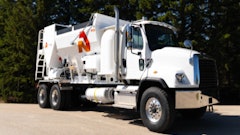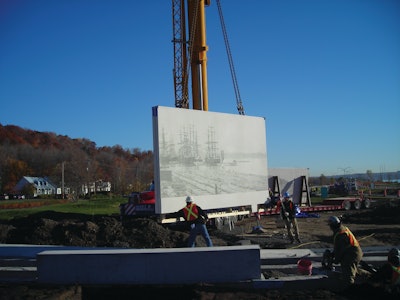
In June 2008, the Promenade Samuel-De Champlain, a riverside walk in Quebec City, was revitalized for Quebec City's 400th anniversary celebration. The project consisted of revitalizing 1.5 miles of coastal landscape along the St. Lawrence River.
The Promenade is split into three sections, one of which includes four themed gardens. In one of these gardens, Tremca Group - the prefabricated concrete manufacturer involved with the project, placed four 12 by 15 foot concrete walls, says Stephan Martineau, technical sales representative for Tremca.
But it's not the concrete walls themselves that are interesting; it's what is on the walls - photographs. The photographs are not painted or stained but engraved into the concrete during the pour using RECKLI Photo-Engraving Formliners. The Promenade Samuel-De Champlain is the first project in North America to use these photo-engraving formliners, says Cindy Russell of Nawkaw - the RECKLI supplier for the United States and Canada.
RECKLI uses a patented polyurethane formliner to create a surface pattern based off the image used. To engrave the formliner, RECKLI uses a computer-based method of transferring the image data onto templates with a computer numerical control (CNC) milling machine and then casting the formliner. Almost any image can be used to create a formliner, and the formliners themselves are scalable allowing contractors to create a formliner of almost any size, according to RECKLI.
"The rubber formliner is actually a negative, so the concrete is poured into the grooved formliner and what pops out is a positive - a series of perpendicular lines of varying thickness" says Russell. "And, the rubber material is so flexible that there is no breakage when concrete, with intricate details, is removed from the mold." These durable formliners are also reusable.
The Promenade project walls are regarded more as an art piece rather than an actual wall in the garden, according to Architect and design team member Caroline Beaulieu, Daoust Lestage inc. - Williams Asselin Ackaoui - Option aménagement. Rather than using the walls as a border, they instead were a means to reproduce historical activities of the site, Martineau says.
Each side of the concrete wall has a different engraved image. "We wanted to refer to the work of the people along the shore during part of the 19th Century," Beaulieu says. "The images reflect what you would have seen if you were there at that time in history."
Another interesting element of the photo-engraved concrete is that the intensity of the photo engraving is altered based on the movement of the sun. So people viewing the photo-engraved concrete may see a different intensity depending on where the sun is and where they are standing.
A concrete wall with this kind of detail may sound like a daunting task, but Martineau says using the formliners was rather easy. First, the images had to be selected, and then they were sent to RECKLI where the actual formliners were created. Then Tremca prepared the wood formwork for the precast walls, Martineau says.
"After fabricating the wood form, we placed the formliner with the negative image engraved into the wood mold. We then prepared the formliner surface by cleaning it and adding a release agent" Martineau says. They also placed rebar in the mold before pouring the concrete.
"The concrete mix was particular for the application," Martineau adds. "We used white cement and white aggregates. This was important to improve the engraving effect." Once the concrete was poured it was vibrated like normal with concrete internal vibrators, Martineau says. Tremca Group then took care of all the engineering to fix all the panels in place on the site.
Because this final art piece is located in a very public place Martineau applied an anti-graffiti sealer to the concrete panels as a precaution.
The engraved images were a first for the design team and the Promenade project, and trying something for the first time can present difficult challenges. "We wanted to take the risk because it's a very interesting way of bringing images to life," Beaulieu says.
Beaulieu said they saw the potential in the photo-engraved concrete and wanted to push the limits as to what had been done with it so far. "Photo engraving was selected for the exactitude of the image reproduction and the durability of the concrete panels," Martineau added.
But it was a risk worth taking. "In the gardens and all along the projects there are many art pieces," Beaulieu says. "We can say that this piece is one of our contributions and participation in this layer of the project."

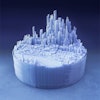
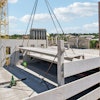

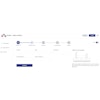

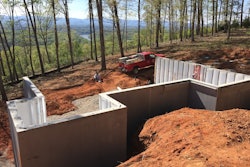
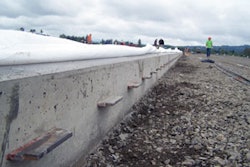


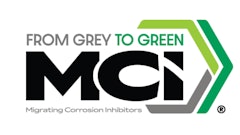



![Fcp Racatac Chair 10893876[1]](https://img.forconstructionpros.com/mindful/acbm/workspaces/default/uploads/2025/10/fcp-racatac-chair-108938761.10l0At5WXv.png?ar=16%3A9&auto=format%2Ccompress&bg=fff&fill-color=fff&fit=fill&h=135&q=70&w=240)





